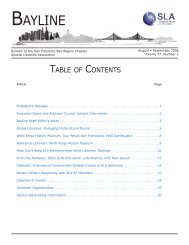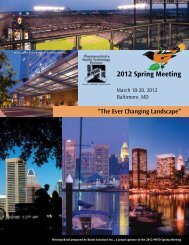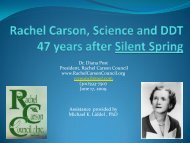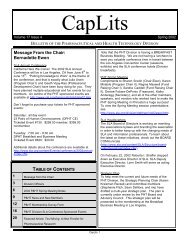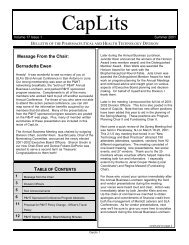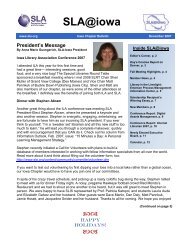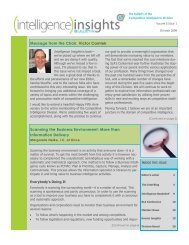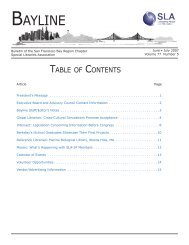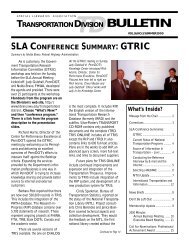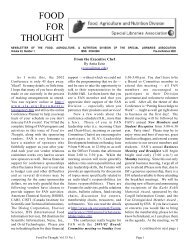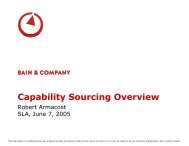Education Libraries - Special Libraries Association
Education Libraries - Special Libraries Association
Education Libraries - Special Libraries Association
You also want an ePaper? Increase the reach of your titles
YUMPU automatically turns print PDFs into web optimized ePapers that Google loves.
exercises, especially reproducibles that can be duplicated<br />
and given to students.<br />
I was also impressed with the section on building a<br />
positive learning culture, which not only takes into<br />
account the different types of learners but also the<br />
teachers’ personalities. Not every teacher needs to have a<br />
sense of humor or be “touchy feely”; the emphasis is on<br />
making teachers aware of their importance in setting the<br />
tone for their classrooms. One way to do this is by<br />
developing a teaching philosophy that can then be shared<br />
with students in the form of a classroom mission<br />
statement. Another is to be aware of the role nonverbal<br />
communication plays in effective teaching.<br />
The primary audience for this book is teachers in grades<br />
4-12. However, much of the research covered involves<br />
college students as subjects, and about half of the handson<br />
exercises are directed at adult learners, so there’s a<br />
great deal here that is useful for teachers in higher<br />
education.<br />
Julie Shen is a Reference/Instruction Librarian at<br />
California State Polytechnic University, Pomona.<br />
Email:jshen@csupomona.edu<br />
Copyright Policies, Clip<br />
Note #39—Reviewed by<br />
Jacqueline Snider<br />
Keogh, Patricia, &<br />
Crowley, Rachel.<br />
(comp.). (2008).<br />
Copyright Policies, Clip<br />
Notes #39. Chicago:<br />
<strong>Association</strong> of College<br />
and Research <strong>Libraries</strong>.<br />
ISBN: 978-0-8389-<br />
8459-8. $45<br />
CLIP Notes published by the <strong>Association</strong> of College and<br />
Research <strong>Libraries</strong> (ACRL) are quite frankly, without a<br />
doubt, a goldmine. From its inception in 1980, this<br />
ACRL program provides college and small university<br />
libraries with reports, surveys, and documents on<br />
specific “best” practices. The Continuing <strong>Education</strong><br />
Committee, which oversees the series, envisioned the<br />
resulting publication as a packet; hence, the name, CLIP<br />
which stands for College Library Information Packet<br />
(Morein, 1985).<br />
“Each CLIP Note is comprised of three components: (1)<br />
information gathered from surveys sent to participating<br />
libraries; (2) analysis of survey results and review of the<br />
literature; and (3) sample documents (e.g., policies,<br />
procedures) pertinent to the CLIP Note topic.” (Clip<br />
Notes, 2006).<br />
The Notes form a code of conduct for all libraries not<br />
just academic, and titles published years ago are still<br />
consulted today. A case in point is CLIP Notes number<br />
22, Allocation formulas in academic libraries (1995).<br />
Every time someone posts a query to a discussion list<br />
about creating budget formulas by specific collections,<br />
someone always mentions this book which was<br />
published more than ten years ago.<br />
When I saw the most recent addition to the Notes canon;<br />
a book on copyright, I was relieved and thrilled. All<br />
libraries deal with the trials and tribulations of copyright<br />
law and need guidance to adhere to requirements and<br />
restrictions. Copyright Policies compiled by Patricia<br />
Keogh and Rachel Crowley does not disappoint.<br />
The book begins by clearly stating that this text does not<br />
represent legal advice. Data were gathered by<br />
<strong>Education</strong> <strong>Libraries</strong>, Volume 31, No. 2, Winter 2008 55



